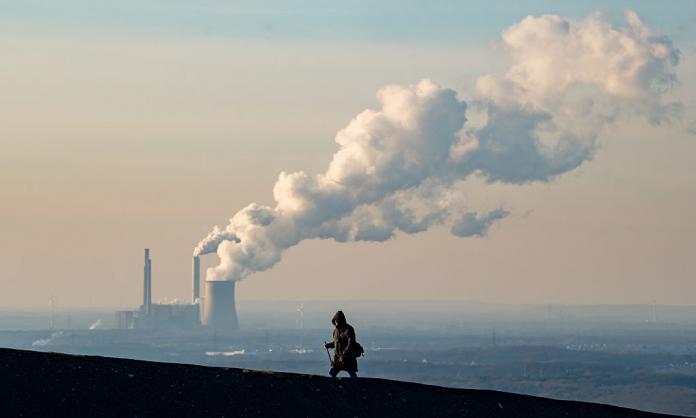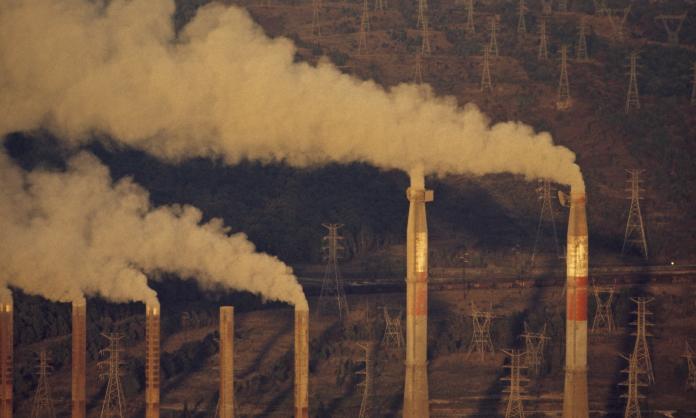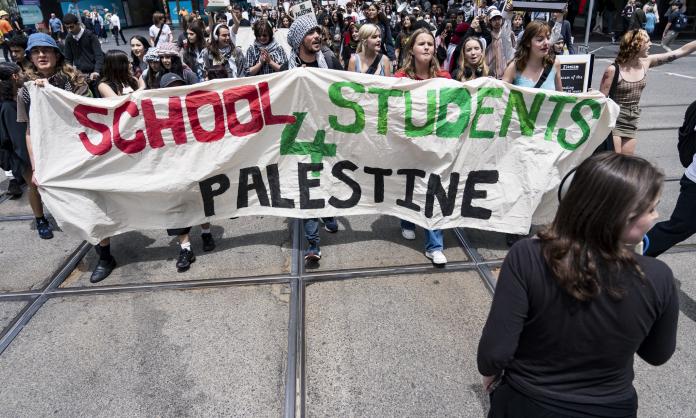Decades of neoliberalism, declining rates of class struggle and defeats for the left have had a profound impact on our ability to imagine an alternative to the current system. Because of this, the immense scale of destruction that capitalism is inflicting on the natural world is, for many people, as much a cause for passive despair as a spur to action. The lack of any real alternative being offered within the political mainstream reinforces this – it appears as though the best we can hope for is to tame capitalism, rather than overthrow it.
With each passing year, however, the case for revolution grows. A vast gulf exists between what scientists think is necessary to avoid a civilisation-threatening climate and environmental breakdown, and what the capitalist class and its political servants think is necessary to preserve their system. The UN Intergovernmental Panel on Climate Change’s (IPCC) 2018 report, authored by 91 scientists from 40 countries, argued that limiting warming to 1.5 degrees would require “rapid, far-reaching and unprecedented changes in all aspects of society”, starting immediately. Yet even the most minor changes fought for by environmentalists are resisted by those in power.
The urgency conveyed by the IPCC contributed to a rise in climate activism around the world. Millions participated in the School Strike for Climate movement. Tens of thousands joined in the disruptive direct actions of Extinction Rebellion. None of this has been enough, however, to force any significant change of course from a ruling class determined to push on with the destructive (and highly profitable) status quo. Even the vastly inadequate targets agreed at the 2015 Paris climate conference now seem out of reach. Emissions continue their steady rise, and new temperature records are set on an almost monthly basis.
Despite the scenes of devastation and horror during Australia’s bushfire crisis, and despite tens of thousands of people mobilising to demand urgent action, neither the governing Liberal-National Coalition nor the opposition Labor Party have agreed to anything more than cosmetic changes to their existing policies. Much has been made of Labor’s commitment to achieving net zero emissions by 2050. But this was merely a recommitment to the policy they took to the last election, and they’ve refused to say whether they’ll maintain their shorter term goal of a 45 percent reduction in emissions by 2030.
Limiting global temperature increases to the 1.5 degrees that the IPCC regards as the “upper limit” to avoid devastating, runaway warming requires emissions cuts of 7.6 percent every year for the next decade. Clearly, neither of the prospective parties of government in Australia are preparing to do this. And their refusal to increase their emissions reduction targets for the domestic economy is only one side of the story. Both major parties support the continued expansion of Australia’s booming coal and gas industries, the massive exports from which, when burnt, produce significantly more emissions than the entire domestic economy.
The COVID-19 crisis doesn’t appear to have changed any of this. The government has indicated that a major expansion of Australia’s already booming gas industry will be central to its post-pandemic recovery plan. If they get their way, this will lock-in further emissions increases for years, if not decades to come. And if Australia does it, why wouldn’t other countries with significant fossil fuel reserves follow suit?
Our political leaders would prefer we all forgot about the country burning around us – the people huddling in boats and on beaches to escape the wall of flames consuming their homes and communities, the more than a billion animals that died, the millions of hectares of forest and precious ecosystems destroyed – so that Australia’s fossil fuel-dependent economy can profit unhindered. If we care at all about the future, however, we can’t allow ourselves to succumb to the illusion that everything is under control, that relatively minor tweaks to the existing system and gradual emissions reductions will be enough and that our society can continue on its current path without any significant change.
The 2018 IPCC report was on the conservative end of the spectrum of scientific opinion on the projected impact of global warming. Increasingly, scientists are talking about the potential for devastation so significant and widespread as to trigger the collapse of entire societies and the unravelling of the global social order in the space of a few decades.
In a widely cited paper from 2018, for instance, Jem Bendell, a professor of sustainability at the University of Cumbria in the UK, argued that “we are set for disruptive and uncontrollable levels of climate change, bringing starvation, destruction, migration, disease and war”. Anticipating that people in developed countries such as Australia might not take this projection seriously, he added: “When I say starvation, destruction, migration, disease and war, I mean in your own life. With the power down, soon you wouldn’t have water coming out of your tap. You will depend on your neighbours for food and some warmth. You will become malnourished. You won’t know whether to stay or go. You will fear being violently killed before starving to death”.
This might seem far-fetched. After Australia’s summer of fire, it shouldn’t. For people in the most severely affected areas, such as the South Coast of New South Wales and the Gippsland region of Victoria, there were weeks when Bendell’s vision of the future climate apocalypse could easily have been taken as a description of contemporary reality. Think of the thousands of people, for example, who at the height of the bushfire crisis, with their communities ringed by flames, were ordered to evacuate. Think of how they must have felt sitting for hours in cars on highways clogged in both directions, not knowing whether they’d make it through before the inferno once again blocked their escape.
For people in many parts of the world, this kind of scenario – so shocking and exceptional to Australians – is already a reality. Already, millions have been forced to flee their homes, in many cases permanently, due to droughts, floods and other extreme weather events. Already, low-lying coastal areas – home to hundreds of millions of people around the world – are threatened with inundation by rising seas. Already, climate change is contributing to an intensification of social conflicts and an increase in the frequency of wars. And already, we’re seeing the poorest and most vulnerable people abandoned to the elements while governments focus on providing security for themselves and their wealthy sponsors.
The ruling class may well be able to adapt to a future of runaway warming and environmental breakdown. They can, in a worst case scenario, retreat to well-guarded enclaves and pay desperate people to maintain them in the conditions to which they are accustomed. For most of the world’s population, this isn’t an option. In the future our rulers envisage, we will be left to burn.
In the German Ideology, Karl Marx wrote that “revolution is necessary ... not only because the ruling class cannot be overthrown in any other way, but also because the class overthrowing it can only in a revolution succeed in ridding itself of all the muck of ages and become fitted to found society anew”. To these two reasons for revolution we need to add a third: it’s only via revolution that we can hope to achieve the scale and pace of change needed to avoid the kind of catastrophic social collapse that Bendell foresees.
The idea that capitalism will self-correct and put us on a path to sustainability is a pipe dream that fits very nicely with our rulers’ desire to continue with business as usual whatever the cost. Periodically, we’re informed by pro-capitalist environmentalists that the reduced cost of renewable energy, combined with changing attitudes among investors and other “decision makers”, means we’re already in a sustainability revolution that will rapidly fix the problem. But while it’s true that investment in renewable energy has grown significantly in recent years, it hasn’t been nearly enough to put a dent in the overall upward trajectory of global emissions.
Even if investment in renewables keeps growing rapidly – and if the 60 percent fall in investment in large scale renewable energy in Australia in 2019 is anything to go by, that’s a very big “if” – when you factor in the growth in overall demand for energy, it’s going to make up only a fraction of the supply for decades to come. Reflecting this, and contrary to what so-called green capitalists might have you think – investors are hardly running for the exits when it comes to fossil fuels. Global investment in renewables may be running at over US$300 billion annually, but total annual investment in energy is around US$1.8 trillion, with over US$700 billion being spent on the oil and gas supply alone. Investment in fossil fuels may be declining as a proportion of total investment in global energy capacity, but in absolute terms the industry is still growing and is projected to continue growing for decades to come.
What hope is there that we can win the change we need through the “proper channels” of our existing political system? The experience of the past few decades has shown how thoroughly corporate power has corrupted the institutions of capitalist democracy. The fossil fuel industry is bound to the capitalist state by a thousand threads. Its influence comes not only through political donations and an army of lobbyists, but through the shared outlook of corporate executives and the politicians and bureaucrats who run the state. When the latter talk about serving the “national interest”, what they mean are the interests of big business and the rich.
When challenged by even the mildest of reformist parties or movements, the capitalist class and its servants in the political establishment do everything in their power to protect the status quo. We saw that with Bernie Sanders in the US. The mainstream media and the Democratic Party establishment pulled out all the stops to prevent him winning the party’s nomination for president. They succeeded. But even if Sanders had, against the odds, actually won the nomination and then the presidency, he would have been stymied at every turn not only by the Republicans, but by the majority of his own party, as well as the vast entrenched power of the unelected bureaucracy, the military and so on.
In The Civil War in France, Marx concluded, based on the experience of the Paris Commune of 1871, that “the working class cannot simply lay hold of the ready-made state machinery and wield it for its own purposes”. In The State and Revolution, Russian revolutionary leader Vladimir Lenin built on this insight, highlighting the need for the working class to smash the existing, hierarchical and oppressive capitalist state entirely. In light of the active connivance of governments everywhere – whether democratic, authoritarian or anywhere in between – in the ongoing destruction of the planet, we can only conclude that similarly extreme measures will be necessary to make the kind of rapid, radical changes we need to tackle the climate crisis.
A crucial part of the neoliberal project has been the inculcation of a sense that any attempt to radically alter the structure of society can end only in disaster. If we don’t hold fast to the existing order, we’re told, the result will be chaos and violence. What we must realise, however, is that it’s the existing order of capitalism that is itself the main driver of chaos and violence. Beneath the facade of order and respectability is the reality of a system already bringing death, destruction and suffering to people everywhere – a system careening out of control towards its, and our, demise.
What, then, might a revolution look like? There’s no shortage of examples from history for us to learn from. Again and again since the dawn of capitalism in the 18th and 19th centuries, workers and the poor have revolted against the established order and the regime of exploitation and oppression on which it is based. The Paris Commune was among the most prominent early examples. Since then we’ve had the Russian revolutions of 1905 and 1917, the German revolution of 1918, the Spanish revolution of 1936, the Hungarian revolution of 1956, the Iranian revolution of 1979, the Egyptian revolution of 2011, and many, many more.
For Marxists, the working class is key to the success of any revolution. Workers are, as Marx famously described them, “the gravediggers of capitalism” for the simple reason that they’re the ones who carry out all the labour that keeps the system running and the profits flowing. The exploitation of workers under capitalism encourages organisation, and when workers organise collectively to withdraw their labour, they can bring the system to its knees. Think of how quickly society would grind to a halt if workers in just a few crucial industries, such as transport, energy and construction, all stopped work at once.
The potential power of workers to disrupt the operations of capitalism is one side of the story. The other is the potential for them to develop institutions of direct democracy that can provide an alternative form of “order” to that maintained by the capitalist state. In the examples of revolutionary situations mentioned above, institutions such as soviets (Russia), workers’ councils (Germany) and shuras (Iran) have sprung up as the need for coordinated action across industries became clear. The furthest development of these institutions occurred in Russia in 1917, where, following the October revolution against the undemocratic “provisional government”, the soviets assumed state power.
Workers’ power in Russia was ultimately crushed through years of civil war, foreign intervention and, ultimately, internal reaction from a new class of state bureaucrats under the leadership of Joseph Stalin. But the example provided by the brief period of genuine soviet democracy in the years immediately following October continues to provide inspiration for those fighting for a better world today. The great achievement of the Russian workers was to show that it was possible to have a society in which decisions are made collectively and democratically, in the interests of human need, rather than everything being geared towards the profits of the wealthiest few.
Revolutions aren’t something to be afraid of. What might seem like chaos from the perspective of the capitalists and their political servants will feel like liberation to those of us on the other side of the class divide. Not for nothing did Lenin call revolutions “festivals of the oppressed and the exploited”. You get a small taste of it every time you’re part of a big, lively protest on the streets: the feeling of collective power – the sense that if you all just unite, you can achieve anything; the joy at momentarily being liberated from the routine drudgery of daily life under capitalism; the feeling of participating alongside others in something meaningful and worthwhile, where your contribution matters. Revolutions make us “fit to found society anew” in part simply because they instil in us the confidence in our ability to run society for ourselves.
Walter Benjamin put it like this: “Marx says that revolutions are the locomotive of world history. But perhaps it is quite otherwise. Perhaps revolutions are an attempt by the passengers on this train – namely, the human race – to activate the emergency brake”. The time for attempting to tinker with capitalism is long gone. We’re in an emergency, and for the sake of our own lives and the lives of future generations, we need to pull the brake.











